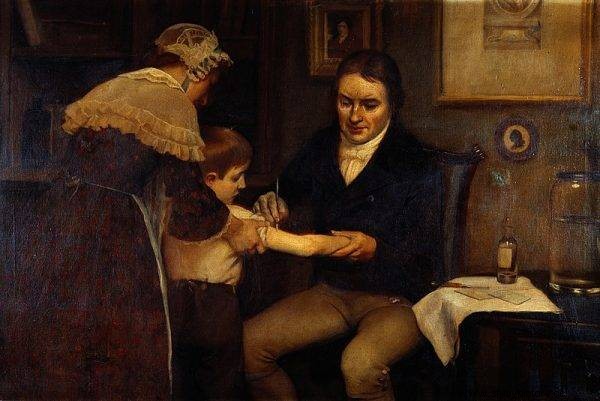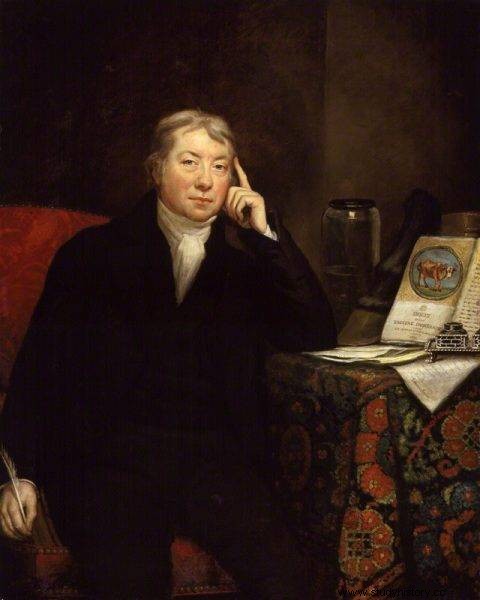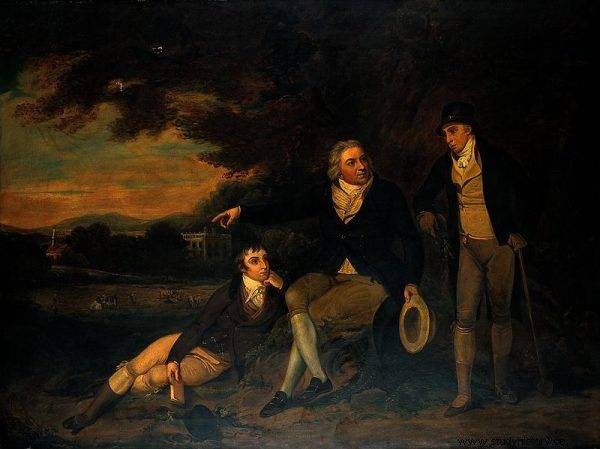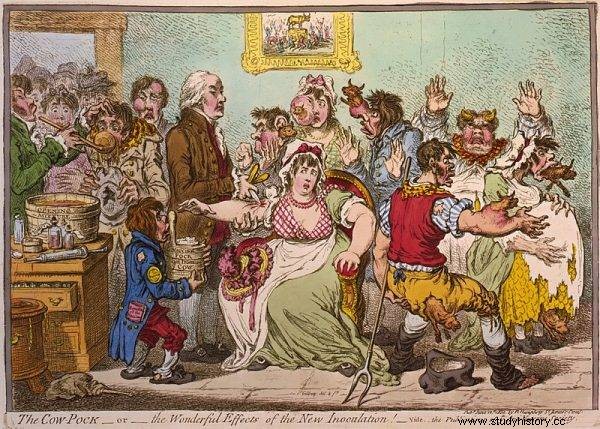A cow, a brilliant doctor and a bit of luck - it was enough to make a breakthrough in medicine. The first vaccine was developed in England at the end of the 18th century.
The first vaccine in history was designed to fight a disease that had taken its toll on mankind for thousands of years. I am talking about smallpox.
Old cure for new troubles
While the world is still licking the wounds of the Covid 19 pandemic, the media reports on a new biological threat to humanity. Recently in Poland appeared the first case of the so-called monkey pox . Is there really anything to be afraid of? Time will tell. But scientists are already pointing out that the smallpox vaccine, which has been available for decades, could effectively protect against the new plague.

However, the modern struggle with smallpox is accompanied by a very interesting story. This is the story of the world's first vaccine. And also about its creator - a brilliant, but not very responsible British doctor.
The history of the fight against smallpox goes back over three thousand years. It was not until 1980 that the WHO officially announced that the disease was finally defeated. As you can see, the success was churned prematurely. More variola vera mutations still pose a threat to humans. However, the modern struggle with smallpox is accompanied by a very interesting story. This is the story of the world's first vaccine. And also about its creator - a brilliant, but not very responsible British doctor.
There was a plague
Smallpox has plagued humanity since the dawn of time. This disease is estimated to be around three thousand years old. It developed in parallel with the great civilizations of the ancient Near and Far East. The first written evidence of the existence of smallpox dates back to around the 5th century BC. Chinese chroniclers reported the pox-like plague. Centuries later, its description is found in the writings of the ancient Greeks, Romans, and Persians.
The spread of smallpox was strongly related to how the lifestyle of a person changed. With the creation of large cities and the development of intercontinental trade routes, smallpox wreaked increasing havoc on the world. According to modern research, it is estimated that only about 5 percent. the population of people in the Middle Ages showed no traces of its disease . Such a high incidence rate was the result of the fact that until the 19th century the rules of smallpox transmission were completely misunderstood. For a long time it was even considered a congenital disease. However, through the centuries of dealing with smallpox, some communities had learned to use some remedies to reduce the risk of getting severe pox.

Mary Wortley and many doctors who imitated her began to popularize in the West the so-called variolization
A difficult word:variation
Mary Wortley Montagu was an English aristocrat who lived at the turn of the 17th and 18th centuries. Her husband, British diplomat Edward Wortley Montagu, became ambassador to the Ottoman Empire. Together with his wife, he settled in Constantinople in 1717. A British woman traveling around the country has repeatedly witnessed an interesting procedure that was applied to local children. The women pricked abscesses in children suffering from smallpox and then infected healthy children with the collected material. Later, Mrs. Wortley learned that this practice had been used for centuries not only in the Ottoman Empire but also in other countries in the Near and Far East.
The aim of the procedure was to infect the body with smallpox in such a way that the disease was as mild as possible. The immunity acquired in this way protected the child against further illness. This method will later be called variolization. In the 18th century, smallpox killed about 10% of people in Europe. population. Mary Wortley and many doctors who followed her began to popularize in the West this type of protection against disease. Already in the second half of the 18th century, variolization became quite common. However, it had its drawbacks. There was always a chance that the disease would not be mild and the infected person would die . After the initial positive reception of variolation, the world of science and medicine began to be more and more skeptical about this procedure. All this prompted an English doctor to try to find a safer way to fight variola vera . He found the solution to the problem in the deep British countryside.
Dr. Jenner
Cow pox, also known as "cow pox", is an infectious viral disease affecting domestic cattle and pigs. In exceptional cases, a person can also become infected with cowpox. The frequent presence of cows in the vicinity of the cows exposed people to infection with the virus, which is why it was the most common among shepherds and dairy women . Fortunately, vaccinia was not a particularly serious disease and its symptoms were limited to rash, fever or enlarged lymph nodes . For this reason, the cow was not subjected to scientific analysis for a long time.

Edward Jenner invented the first vaccine ever
The first medically documented cases of the disease date back to the mid-18th century. Its occurrence began to be watched more closely, when it turned out that the disease of vaccinia is associated with an interesting side effect - the acquisition of resistance to infection with smallpox. One of the researchers investigating this issue was the British physician Edward Jenner. Born in Berkeley in 1749, Jenner became a surgeon's apprentice at the age of fifteen, and after completing his apprenticeship, he went to London and earned his doctorate in medicine. In 1773 he returned to his homeland. In the local community, he has built a reputation as a "philosopher of medicine" and a natural scientist, and at the same time a nice and kind man.
Jenner first heard of vaccinia from a young woman in the neighborhood. From around 1770, he began to closely examine the correlation between vaccinia infection and insensitivity to smallpox. He visited local dairy farms. He observed the changes in the skin caused by vaccinia on the hands of shepherds and examined the progression of the disease in cattle and humans. In the end, he decided to conduct an experiment which - as it turned out later - changed the face of medicine once and for all.
Experiment
In 1796, Jenner learned that the local dairy Sarah Nelmes was possibly infected with cow pox. When he arrived, he examined the girl and her cow named Blossom. The rumors were confirmed. Both suffered from cowpox. Now is the time to experiment. The test subject was James Phipps, eight-year-old son of the gardener Jenner, who agreed to the procedure . Jenner incised the boy's skin and introduced a purulent fluid under it from the scabs at the hands of Nelmes .
Even in those days, such a casual approach to medical testing and experimentation was very controversial. The doctor enjoyed great trust in the local community, thanks to which he was able to perform the procedure without unnecessary formalities. Years later, frustrated by the inability to experiment as freely in London, he wrote to his friend:" In the countryside I can always find little villagers where I can introduce the vaccine virus in any form" .

Jenner incised the boy's skin and injected a purulent fluid under it from the scabs from Nelmes hands.
Jenner also didn't mind experimenting with his own children. (Both of his sons were vaccinated against various types of smallpox.) Meanwhile, James Phipps, vaccinated with vaccinia, underwent the procedure exceptionally well. One week after immunization, the boy had a mild fever and a headache, but was otherwise healthy. Jenner was disheartened by the experiment. He believed that since the symptoms were so meager the infection would not save the boy from smallpox . Imagine his surprise when a few weeks later James Phipps turned out to be completely immune to the disease. The first ever vaccine has just proven effective.
Save the world
Immediately after the experiment, Jenner prepared a short article describing its course. He sent the text to the Royal Society (British Academy of Sciences). However, the president refused to publish it in 1797, on the grounds that the ideas contained therein were too revolutionary. Undaunted by the refusal, Jenner extended his observations. He made more tests. A year later, himself published a brochure entitled " Research into the causes and effects of cowpox" . The medical world has finally admitted that the procedure performed by Jenner actually immunizes a person against smallpox infection. The next thing went quickly.
Jenner's work has been translated into many languages. More countries have started to vaccinate their citizens on a massive scale. Within three years of the publication of the work, around 100,000 people in England have undergone surgery . The vaccination process also began very quickly in France. Napoleon, who gave the vaccines an ideological aspect, made special contributions in this field. He saw in them a symbol of the strength of an enlightened and authoritarian state.
In other countries, too, vaccination was promoted by native rulers. Their huge supporters were both Thomas Jefferson and Tsar Alexander I. In 1803 a special expedition (the so-called Balmis expedition) transported the vaccine across the Atlantic and gave rise to a vaccination program in the Americas. The Church was also in favor of vaccinations. Some clergymen not only encouraged to undergo the procedure, but also performed it themselves. Pope Pius VII called Jenner's vaccine:" A precious discovery that should be a new motive for human gratitude to the Almighty."
Vacca means cow
The invention of the vaccine was a turning point in world history. For the first time, a simple medical procedure has made it possible to save millions of human lives from death. The nature of man, however, is that he is afraid of the unknown. So even in the face of a life-saving discovery, he remains wary.
In the case of the Jenner vaccine there were immediately many voices criticizing its medical, social and philosophical dimensions. Despite the clear position of the Church, it was argued that the introduction of a foreign substance into the body was ungodly and was against the will of the Creator. There were rumors that vaccinia is nothing but a venereal disease of cattle. Caricaturists drew people who grew horns and tails after inoculation, and their bodies were covered with bovine hair.

A cartoon showing the alleged side effects of vaccination
However, thanks to its unquestionable protective effect, the smallpox vaccine became more and more common. The process of its distribution and production was constantly improved. Jenner's work was continued by the brilliant French chemist and father of microbiology, Louis Pasteur, who developed a rabies vaccine a century later. It was he who, in recognition of the merits of his British predecessor, proposed that all substances that create immunity to a given pathogen in humans should be called vaccines (the word vaccine comes from variolae vaccinae - Latin name for cowpox).
